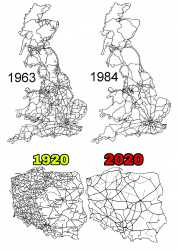>>2013432Simply put, most of what is shown on the left was built when your choices of transport were train, horse or walk.
Any are that had no train-access was absolutely screwed. They could run no industry, could not easily recieve or send goods and traveling to or from there was a huge pain in the ass.
Often also the military stepped in (at least in Germany) and demanded another line so they had a chance to move troops and material in that area should they need to.
So a very fine grid of railways was built out of sheer necessity. Many of those lines were never 'profitable' in the sense of revenue carrying the cost. They made sense because without them the whole area was economically bankrupt.
Now a few years later trucks, buses and cars had become very viable modes of transport and roads had been built to make them usable. And they were improving steadily.
Increasingly the one or two cars of loose cargo that would be pushed into some little village became less full, fewer people bothered traveling with the sparse rail service.
The dire need for these lines was gone.
The absence of automation led to a lot of people being needed to operate these lines at any kind of effectiveness.
They would certainly not have been built again. Some were closed already in the '50s due to being ridculously expensive to run for no purpose, others made enough sense at least to keep them running while the material would work without major invest.
Additionally, small factories that used to be everywhere along the lines were increasingly closing. Manufacturing of various goods was consolidating into a few major factories and/or relocating overseas. This further killed of freight customers out in the boonies.
For Germany, many lines were kept alive with cheap railbuses, but as major investments became necessary, and neither freight nor passenger service justified even the operating cost anymore, lots of lines were abandonned throughout the second half of the 20th century.

